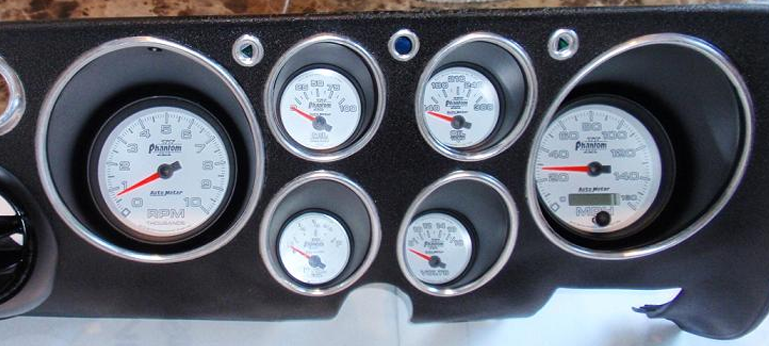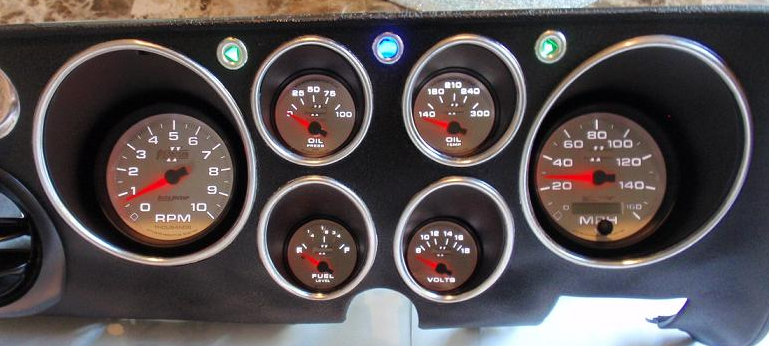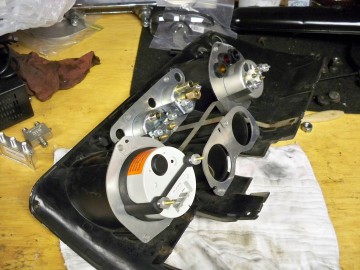Electric Speedometer Conversion - Junkyard Builder
Jeff Smith, writer, Apr 1, 2014
We don't have to tell you that late-model overdrive transmissions have become a prototypical upgrade for any kind of performance car. The number and variety of these transmissions makes that decision pretty easy. So let's say you've jumped into the deep end of the pool and stuffed a 4L80E automatic or a T-56 six-speed into your Chevelle, and at some point in the conversion, you realized that these gearboxes long ago flushed those clunky gear-driven mechanical speedometers. Every late-model transmission now transmits what is called a vehicle speed sensor (VSS) electrical pulse. Yes, there are aftermarket extension housings that convert to a mechanical drive if you want to go that route, but we were looking for something that integrates the smoothness and accuracy of a late-model electric speedometer.
There are several ways to go about this electric conversion. Let's start with the easiest route. Let's use the example of a first- or second-generation Camaro running a 4L60/70/75E or the 4L80/85E. These electronically controlled overdrives require a dedicated electronic transmission control unit. We previously tested five of these units ("In Control," Mar. '12). If you are using one of these control boxes, all of them output a vehicle speed signal that will work with most aftermarket electronic speedometers. In the case of the CompuShift II box, the output is even adjustable.
Now let's assume you are using a factory manual overdrive like the T-56 six-speed. These transmissions typically output a signal from the VSS, which can be wired directly to an electronic aftermarket speedometer. The aftermarket speedos, such as those from Auto Meter or VDO, are designed to be calibrated by simply pushing a button on the speedo, driving a known distance (2 miles in the Auto Meter example), and punching the button again. This calibrates the speedo to your particular tire size and gear ratio, making the setup ridiculously easy.
The only time you might need a calibration box would be if you were trying to calibrate a late-model transmission to a factory electronic speedometer. Classic Instruments sells a simple-to-use box, as does Dakota Digital and Auto Meter. As an example, connect the VSS output to the Classic Instruments unit and then wire it to the speedometer. Hit the button on the interface, drive the car an exact measured mile, and hit the button again. This calibrates the VSS signal into the speedometer from the VSS output, and the speedometer will be accurate. This box, the SN-74, is an upgraded version of Classic Instruments' original box that eliminates flipping dipswitches. This conversion box would only be required when working with a factory-style speedometer.
Another route will eliminate connections to the transmission altogether via a GPS speedometer signal. Auto Meter, Classic Instruments, and others sell a GPS box with an antenna that triangulates from a minimum of three geo-synchronized satellites to establish very accurate speed and distance information that is fed to the speedometer. These units will work with virtually all aftermarket electronic speedometers. The only downside to these that we see is they sometimes require a minute or so to establish satellite contact and can lose signal in long tunnels.
So then the issue comes down to finding an electric speedometer. The simplest approach is using an aftermarket unit from companies such as Classic Industries, Auto Meter, Speedhut, or Stewart-Warner. On the budget side, Auto Meter makes an inexpensive 120-mph electronic aftermarket speedometer in a 318-inch diameter that sells for only $135 from Summit Racing. We also found a Speedway Motors 120-mph speedo for $69. Budget speedometers generally need an interface box to calibrate the signal between it and the VSS sender. The Auto Meter unit might be a better deal because it does not need an interface.
Car Craft family member Tim Moore pulled an 85-mph electronic speedo out of a '90s Chevy van for $20 that could be a budget alternative. The problem is finding a factory speedometer that will fit your dash and still looks like it belongs. That will probably not be easy. We spoke with Shannon Hudson at Redline Gauge Works, who told us you should be able to use a Dakota Digital or Classic Instruments interface box to adapt the signal from the transmission to the specific requirements of a factory digital dash, but he was not willing to say that these boxes would be compatible in all situations.
As a more useful alternative, Hudson told us that he regularly converts older mechanical speedos to electronic, and if that's all you want done, it can cost as little as $300$350. This conversion will also create a digital odometer reading, so the revamped speedo won't be exactly stock. Shannon says that most of his customers actually prefer the digital odometer.
So there you have it, a quick rundown of some of the electric speedo options for an aftermarket overdrive transmission in an older car. There really isn't a stupid-cheap $29.95 option but neither is converting to an overdrive automatic or manual transmission. Of course, if you've ever lived with an ancient, needle-bouncing, cable-driven speedometer, you already know that these should be more accurately called a speed suggestion gauge. And that's after you've spent hours calibrating it with handfuls of plastic gears. We've been there, and that just makes an electric speedometer much more attractive for a host of low-stress reasons.
https://www.perfvair.com/dash-parts-steering-columns/
Performance Corvairs
Seth Emerson
3462 Kirkwood Dr.
San Jose, CA 95117
Email: Sethracer@aol.com
Phone: (408) 247-2237
Kit includes 4 separate plates, Speedo/Tach/Upper center gauge pair/Lower center gauge pair. Fits – 1965-66 Corsa Dash. (The Corsa Dash will fit into 65-69 cars). Parts are usable individually or in any combination. Upper pair and lower pair are replaced as a pair of gauges. Plates retain the gauges from behind, pressing them up against the back side of the dash. No cutting or modifications to the dash panel are needed. Use original mounting screws. Stock Speedo can be retained. Standard 3 3/8” Speedo/Tach and 2 1/16” aftermarket gauges work fine. Cost $44 + $8.50 shipping. Add $3.96 sales tax, if shipping to an address in California.
VDO Vision Black 120MPH 4 in. Electronic Speedometer with Autocalibration - 437 155

Vision Instruments feature crisp black dials and matching bezels. High contrast clear white graphics and red pointers make Vision instruments easy to read. VDO patented movements provide smooth and accurate performance and long life dependability. Standard 0.25" spade connectors simplify wiring and VDO Spin-lok™ mounting makes installation fast and easy while providing a full 360° degrees of mounting force. Included light diffusers allow the dial illumination color to be changed to red or green. Other gauges are also included in the series, including an analog clock, transmission temp, oil temp, etc.
GPS Speed Sender
This sender transmits 16,000 or 200,000 pulses per mile driven (depending on your wiring preference in step #2). When used with a VDO speedometer (purchased separately), you can calibrate the speedometer to the GPS sender by:
A. Following the instructions for auto-calibration
B. Follow the instruction for manually inputting the
pulses and entering 200,000 pulses when prompted.
This GPS speed sender has a special feature that allows it to continue to transmit the last known speed during operation, if it should lose connection with all GPS satellites. If that should happen, the GPS status light will flash orange until connection is regained with at least 1 satellite. Your speedometer will continue to indicate the last known speed until such time that a connection is reestablished. Note: Once connected to a power supply, the VDO GPS Speed Sender functions automatically, and requires no further input or actions to be taken by the user. There are no adjustments or user serviceable components in the housing.





 1966 Corvair Corsa Convertible
1966 Corvair Corsa Convertible